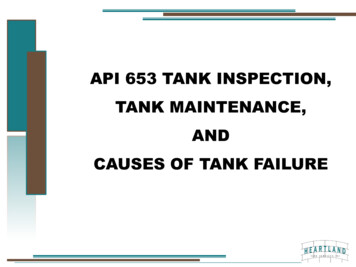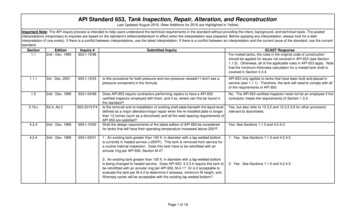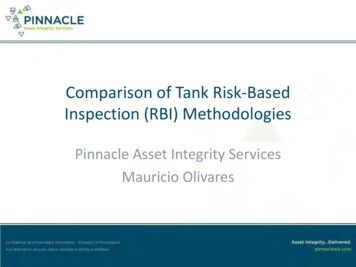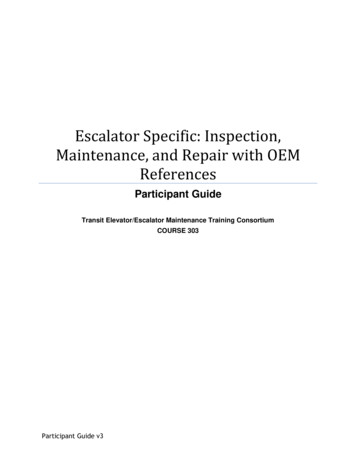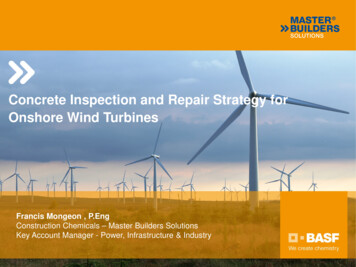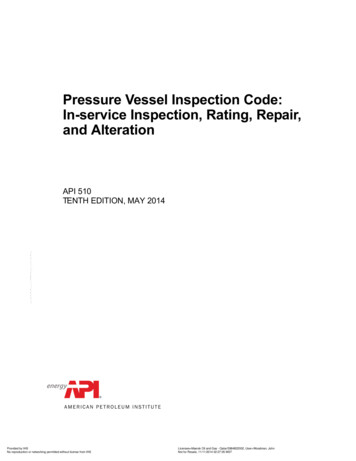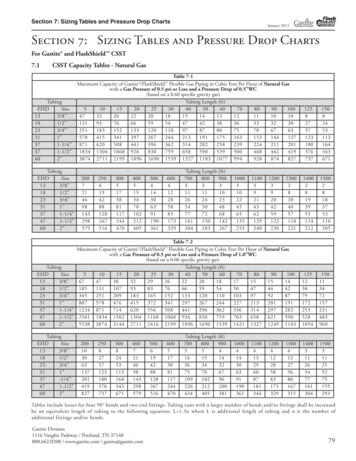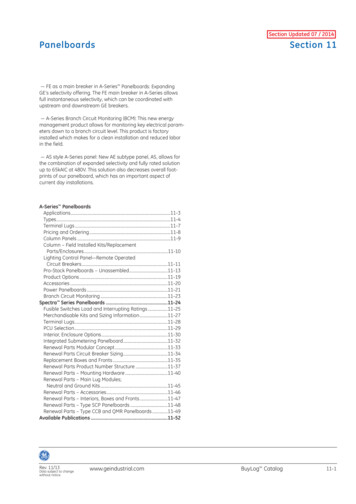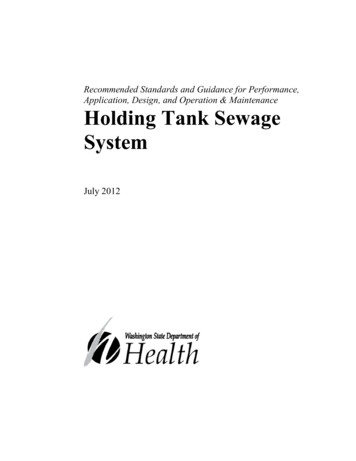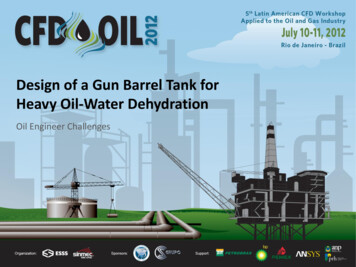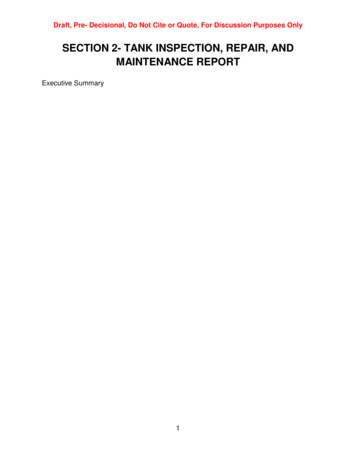
Transcription
Draft, Pre- Decisional, Do Not Cite or Quote, For Discussion Purposes OnlySECTION 2- TANK INSPECTION, REPAIR, ANDMAINTENANCE REPORTExecutive Summary1
Draft, Pre- Decisional, Do Not Cite or Quote, For Discussion Purposes OnlyPART A – INTRODUCTIONCHAPTER 1- REPORT INTRODUCTION1-1BACKGROUNDSince the inadvertent fuel release from Red Hill Tank 5 that occurred from 9 Dec 2013to 17 Jan 2014 there have been hundreds of phone calls, written communications, andface-to-face meetings among the stakeholders at Navy, DLA, EPA, and HIDOH;interested parties including the Oahu Board of Water Supply, the Honolulu media; stateand local elected officials; and the general public. All want to know what happened,why it happened, the nature of the threat to the fresh water aquifer on Oahu, what canbe done to stop the fuel before it reaches the aquifer, and what can be done to makesure something like this never happens again. The end result of all the dialogue is theAdministrative Order on Consent (AOC) between Navy/DLA and EPA/HIDOH that wasfinalized and signed in September 2015. The AOC outlines a way forward to answerthe questions raised and plans an overall course of action comprised of multiple subcourses of action to resolve the issues at hand. This report expands on the AOC outlineas described in the following paragraph.1-2PURPOSE AND SCOPEThe purpose of the TIRM report is to review and expand upon the issues that have beenagreed to by Navy/DLA and EPA/HIDOH in the Administrative Order on Consent (AOC)as important for the future inspection, repair, and maintenance of the Red Hill tanks toinsure that the goal of keeping the tanks permanently leak-free going forward can bemet. The report examines the pros and cons of past, current, and emerging means andmethods for work on the tanks in order to decide on a strategy that can best achieve thegoal of leak-free tanks.1-3HISTORY OF TIRM AT RED HILLThis section will discuss the historical TIRM standards that have been performed in thepast.2
Draft, Pre- Decisional, Do Not Cite or Quote, For Discussion Purposes OnlyCHAPTER 2 – GENERAL CONSTRUCTION ISSUES2-1LOCATION2-1.1MOBILIZATIONa. Transportation of Equipment And Material From/To Mainlandb. Transportation of Equipment And Material From/To Tank2-1.2Qualified Personnel2-2SECURITY2-2.1Qualified personnel with clean record2-2.2Time to obtain security clearances2-3POWER2-3.1Equipment that needs power2-3.2Clean Air Act vs Generators2-4WATER2-4.1Location of closest water source2-4.2Quantity of water required2-5VENTILATION2-5.1Confined Space Permit Requirements2-5.2Equipment Requirements2-5FUEL INVENTORY2-5.1Mission Requirements (not detailed)2-6ACCESS TO TANK2-6.1Tunnels2-6.2Manway2-6.3Equipment3
Draft, Pre- Decisional, Do Not Cite or Quote, For Discussion Purposes OnlyPART B - TANK 5 CLEANING, INSPECTION, REPAIR ANDMAINTENANCE PRACTICESCHAPTER 3 – TANK 5 CLEANING3-1INTRODUCTION3-2SUMMARY OF THE PROCESS SELECTED3-3BASIS FOR WHY THIS PARTICULAR PROCESS FOR CLEANING WASIMPLEMENTED3-4SUMMARY OF RECORDS3-5ALL IMPORTANT AND SUPPORTING RECORDS CONTAINED IN REPORTAPPENDIX3-6QUALITY ASSURANCE AND QUALITY CONTROL PROGRAM FORCLEANING4
Draft, Pre- Decisional, Do Not Cite or Quote, For Discussion Purposes OnlyCHAPTER 4 – TANK 5 .1.34-2.1.44-2.1.5SUMMARY OF THE PROCESS SELECTEDNon-Destructive Testing – InspectionLow-frequency electromagnetic testing (LFET)Balanced-field electromagnetic testing (BFET)Longitudinal Ultrasonic Testing (UT)SHEAR WAVE ULTRASONIC TESTINGGeneral: Unspecified If Longitudinal or Shearwave UT4-3TEST PERSONNEL AND CERTIFICATIONS4-44-4.14-4.24-4.3TANK INSPECTION PROCESSTank Inspection Test Order of WorkGeneralScheduling4-5OTHER INSPECTIONS (coatings, structural, checklist)4-6NOZZLE INSPECTIONS4-7TANK CLEANING PROCESS METHODOLOGY Basis for why this particular process for inspection was implemented4-84-8.1SUMMARY OF RECORDSAll Important and Supporting Records Contained In Report Appendix4-9QUALITY ASSURANCE AND QUALITY CONTROL PROGRAM FORINSPECTIONProcess of Verifying Proper Operation Of Test EquipmentQuality Control During Inspection And Testing4-9.14-9.25
Draft, Pre- Decisional, Do Not Cite or Quote, For Discussion Purposes OnlyCHAPTER 5 – TANK 5 STRUCTIVE TESTING – REPAIRVISUAL INSPECTIONMagnetic-particle testing (MT)Dye-penetrant testingVacuum testing:5-3TEST PERSONNEL AND CERTIFICATIONS5-4OTHER INSPECTIONS (coatings, structural, checklist)Provide a summary of the structural integrity of the center column, and anyrepairs that were required prior to inspection of the tank.5-5REPAIR RECOMMENDATIONS5-65-6.1REPAIRS – WELDINGProvide a narrative of what needed to be welded, and the type of weld that isrequired (ie: fillet weld).Discuss the drilling of the hole in the tank prior to welding. Why it was done.Provide an Appendix G of the Welder Qualifications, Weld ProcedureQualifications, and Weld Procedure Records. – The PQR & WPS’s are onEPA’s web site.5-6.25-75-7.15-7.2TANK REPAIRS – MISCELLANEOUSProvide a list of other repairs that were required.Provide description of how the repairs were performed.5-8TANK REPAIR PROCESS METHODOLOGYBasis for why this particular process for inspection was implemented5-95-9.1SUMMARY OF RECORDSAll important and supporting records contained in Report Appendix5-10QUALITY ASSURANCE AND QUALITY CONTROL PROGRAM FORREPAIRWelder Identification Marking5-10.16
Draft, Pre- Decisional, Do Not Cite or Quote, For Discussion Purposes Only5-10.25-10.35-10.4Provide a narrative of how each weld was marked by each welder, and thenalso included in Willbros’ QC log.Weld Visual InspectionProvide a narrative of how each weld was visually inspected and documentedin Willbros’ QC log.QC Log Of InspectionsProvide a description of Willbros’s QCQA Review Of Log Of InspectionsProvide a description of Government’s QA7
Draft, Pre- Decisional, Do Not Cite or Quote, For Discussion Purposes OnlyCHAPTER 6 – TANK 5 REPAIR VERIFICATION (WARRENTY WORK)6-1INTRODUCTION6-2SUMMARY OF THE PROCESS SELECTED6-3TANK REPAIR VERIFICATION PROCESS METHODLOGYBasis for why this particular process for inspection was implemented6-46-4.1SUMMARY OF RECORDSAll important and supporting records contained in Report Appendix6-5QUALITY ASSURANCE AND QUALITY CONTROL PROGRAM FORREPAIR VERIFICATION8
Draft, Pre- Decisional, Do Not Cite or Quote, For Discussion Purposes OnlyCHAPTER 7 – RECOMMISSIONING7-1INTRODUCTION7-2SUITABILITY FOR SERVICE STATEMENTProvide a narrative of documentation received from Willbros stating that thetank was suitable for service and that it can go back into service. Thisstatement is a requirement of the SOW (include excerpt from SOW and thesuitability for service statement).7-37-3.17-3.2TANK FILLING PROCESSProvide a narrative of how the filling process was monitored.Reference MO-230 and UFC 3-460-03 if applicable.7-4TANK RECOMMISSIONING PROCESS METHODOLOGYBasis for why this particular process for recommissioning was implemented7-57-5.1SUMMARY OF RECORDSAll important and supporting records contained in Report Appendix9
Draft, Pre- Decisional, Do Not Cite or Quote, For Discussion Purposes OnlyCHAPTER 8 – ADDITIONAL INFORMATION TANK 58-1INTRODUCTION8-2RECORD KEEPING Provide a narrative of the documents that are required to be kept as partof the Contract file. Reference the Instruction (I need that training again)that mandates this requirement. Provide a narrative of the documents that are required to be kept per API653 and/or the State of Hawaii (33CFR?). Provide how these documents are stored.8-38-3.18-3.2MAINTENANCE OF TANKS IN RED HILLProvide the list of tank maintenance requirements from MO-230.Provide the maintenance checklist for Tank 5 (From FLC).8-4BASKET POSITIONING (SCAFFOLDING) General usage note: The Willbros report states, “After all of the structuralrepairs (on the center tower) were completed and checked, Willbrosinstalled two (2) boom systems on the tower structure with man baskets.The man baskets were utilized to access all the internal surfaces areas ofthe tank for testing and inspection” (p. 19). Use in lower dome Use in barrel Use in upper dome Positioning Basket positioning process methodology10
Draft, Pre- Decisional, Do Not Cite or Quote, For Discussion Purposes OnlyPART C – LESSONS LEARNEDCHAPTER 9 – OBSERVATIONS AND INCIDENT INVESTIGATION9-1INTRODUCTION9-29-2.19-2.1.1TANK 5 INCIDENT INVESTIGATIONIncident CauseRepairs Provide narrative that the Contractor was not working from drawings orrepair procedures. The welds were not good and the hole was not plugged.Incident Reporting and ProcessDesign Errors and Omissions and Construction Warranty Provide the Government’s process for reporting and responding to errorsand omissions in the design and warranty issues during construction.(FAR clauses).9-2.1.29-2.1.39-49-4.19-4.2FILLING PROCEDURESProvide the Government’s process that was used to fill Tank 5.Provide discussion about the new filling instruction.9-5ANY ADDITIONAL DETAILS NAVY/ DLA WANT TO ADD9-69-6.1ADDITIONAL OBSERVATIONSInspection Discussion Inspection methods were sound. Provide narrative that the API 653inspection was sound, used the right equipment and personnel.9-79-7.1PREVIOUS TANKS INFORMATION AND OUTCOMESProvide documents and other information Provide a narrative stating why there was a failure in Tank 5, but not theother tanks. Provide documentation that the inspection was the same.Provide documentation of what was repaired in the other tanks. Provideinformation concerning the other prime contractor’s quality controlprocedures.11
Draft, Pre- Decisional, Do Not Cite or Quote, For Discussion Purposes OnlyCHAPTER 10 - Lesson #1 Contracting10-1INTRODUCTION10-210-2.1SUMMARY OF FAR REQUIREMENTSContracts: The Government is required to abide by the Federal AcquisitionRegulations (FAR)10-310-3.1CONTRACTING FOR TANKS PRIOR TO TANK 5From the contract information in Appendix D, the following is a list of thecontracts for the five tanks in the order they were worked prior to Tank 5:Type of ContractProcess to AwardObservations for tanks Prior to Tank 5Inclusion of Available Contracts in Report -4.3CONTRACTING FOR TANK 5Type of ContractProvide a general overview of the type of contract that was used for Tank 5.(Services vs Construction)Inclusion of Tank 5 Contracts in Report Appendix10-5BACKGROUND TO DEVELOP STATEMENT OF WORK Provide the background of the development of the Statement of Work.10-6PROCESS TO AWARD Provide a general overview of the process to award this type of deliveryorder.10-7FUNDING AND WORK CLASSIFICATION Provide a general overview of the funding – minor construction, repair,and maintenance.10-8OBSERVATIONS AND SHORTCOMINGS OF CONTRACTING FOR TANK 5 Lesson learned: The contract must be more specific to explainexpectations. As a lesson learned, the Navy/DLA is changing theirprocess to require drawings and procedures. More on this topic will beexplained in Chapter 16 Quality Control and Assurance of TIRM andChapter 17 Options for improving current TIRM.12
Draft, Pre- Decisional, Do Not Cite or Quote, For Discussion Purposes Only10-9CONTRACTING SOLUTION OR IMPROVEMENT13
Draft, Pre- Decisional, Do Not Cite or Quote, For Discussion Purposes OnlyCHAPTER 11 - LESSON #2 CONTRACTOR QUALITY CONTROL11-1INTRODUCTION11-211-2.1OBSERVATION AND SHORTCOMINGContractor Quality Control Provide a summary of how the Contractor’s Quality Control system wasnot effective since the Project Manager was also the Quality ControlManager. Provide a narrative on the lack of specifications and drawings.11-3SOLUTION OR IMPROVEMENT Reference Chapter 16.14
Draft, Pre- Decisional, Do Not Cite or Quote, For Discussion Purposes OnlyCHAPTER 12 - LESSON #3 REFILLING ON AND SHORTCOMINGTank Filling ProceduresProvide the Government’s process that was used to fill Tank 5.12-3SOLUTION OR IMPROVEMENT Provide discussion about the new filling instruction.15
Draft, Pre- Decisional, Do Not Cite or Quote, For Discussion Purposes OnlyCHAPTER 13 - LESSON #4 GOVERNMENT QUALITY ASSURANCE13-1INTRODUCTION13-213-2.1OBSERVATION AND SHORTCOMINGGovernment Quality Assurance Provide a narrative of why there was limited Government QualityAssurance provided during the execution of this contract. Includeconfined space requirements. Discuss the lack of a good QualityAssurance Surveillance plan. Since there was a lack of specifications anddrawings, the Government QA engineer had no basis to determine if thework was per the contract or not.13-3SOLUTION OR IMPROVEMENT More Detail in Chapter 1616
Draft, Pre- Decisional, Do Not Cite or Quote, For Discussion Purposes OnlyCHAPTER 14 – LESSON #5 CLEANING AND INITIAL INSPECTION14-1INTRODUCTION14-214-2.1OBSERVATION AND SHORTCOMINGPressure Washinga. The Government specification does not specify the maximum allowablepressure and temperature for pressure washing.b. Reference 1, Section 4.5.1.2. “A high pressure spray wash of the tankinterior and internal components shall be conducted.” The pressure forcleaning Tank 5 is not specified.c. Reference 1, Appendix D, SOP #5 Water Blasting. Specification lists thefollowing categories of water blasting:d. Reference 2, Section1.0. “Willbros cleaned the tank by high pressurewashing all internal surfaces.” The actual pressure used for cleaning Tank5 is not specified.e. Reference 2, Section 6.1, Summary of Indications and Flaws. “Thecoating has disbonded, flaked, or deteriorated over 80% of all internalsurface areas.”NOTE: In none of the previous five tanks was the coating in the Upper Domeand Barrel so badly deteriorated. The condition of the coating in theLower Dome was consistent with the previous tanks.14-314-3.1SOLUTION OR IMPROVEMENTLessons learned for Tank Cleaninga. Government specifications shall specify the maximum
23.03.2016 · Provide a narrative of the documents that are required to be kept per API 653 and/or the State of Hawaii (33CFR?). Provide how these documents are stored. 8-3 MAINTENANCE OF TANKS IN RED HILL . 8-3.1 Provide the list of tank maintenance requirements from MO-230. 8-3.2 Provide the maintenance checklist for Tank 5 (From FLC). 8-4 BASKET POSITIONING (SCAFFOLDING)
